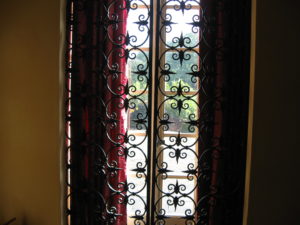Three years as students in London meant plenty of visits to Greenwich but for reasons we can’t explain never once did we go to Eltham Palace. Now the failure is even more inexplicable.
After an evening at the theatre we stayed as near London as we could afford, and found ourselves a couple of miles from Eltham. Why not see what we’d missed all those decades ago? And a couple of miles onward would be Greenwich, where the Queen’s House has reopened with the Armada Portrait as – for us at least – its chief treasure.
Just before 10 on a morning that threatened showers and often delivered worse we spotted the brown sign and knew we were almost there. Perhaps confused by its recent name-change from English Heritage to Historic England – still not on public display – the gates remained firmly locked as three cars and two pedestrians waited. Not for long, however, and by five past we were in the car park.
From reception to the house is a walk through gardens and over the moat. More of that to follow: the approach gives a fine view of the medieval hall restored after centuries of neglect and its eclectic “extension” where the Courtaulds lived. An audio guide included with the admission price gives a very informative if somewhat twee explanation of all that went into creating the controversial but eminently justifiable development.
Medieval can wait: for anyone familiar with the great Cunard interiors the art-deco reception hall that looks circular but actually has three curved sides is essential The Swedish carpet – to call it rug would be an insult – is one of the finest items of design I’ve ever seen. The guardian figures in the panelling are outstanding. Tempting as it is, the guide advises not remaining but to take the stairs to Virginia Courtauld’s bedroom.
Luxury in essence: the bedroom has onyx panels and fittings; Cleopatra would have approved, though there is nothing risque about coming straight here. The windows bring in views of the gardens to calm your feelings.
The audio guide explains the many jazz-age gatherings hosted by the Courtaulds, as well as their menagerie, not only dogs of various sizes but a lemur and a parrot. It could be from a novel by Evelyn Waugh.
By the time the various upstairs rooms have been seen, each with one exception (for two nephews) given its own bathroom, a passage leads towards the minstrels’ gallery. That was also a creation of the Courtaulds’ architects but surely replaced an original. Just before reaching it is a small room with items found during excavation.
Armchairs in the gallery allow visitors time to sit and gaze into the hall, which is huge. To give some idea, even the gallery had accommodated the Lou Stone band playing for dancing below. As the hall had been almost completely ruined in the centuries after the Civil War the reconstruction was informed by both historical research and not a little imagination. Stained glass and coats of arms had been installed to represent the numerous royal houses that had used Eltham, from Plantagenet to Stuart, and period chests and stools had been purchased. The outright fantasy is a Doge’s throne – oddly – at the low end of the hall.
For a return to reality with 1930s luxury a passage from the corner of the hall leads to a conservatory. This is a different place for sitting and reflecting. Outside is a lawn with flowerbeds and more cane furniture for fine days.
Now finally the reception hall can be appreciated with the dining room, drawing room and library, not to mention Mrs Courtauld’s boudoir. There, in an annexe, will be the record of the Courtaulds’ travels, in maps used as they used them for wallpaper. A feature of the family was travel, either taken themselves or in sponsorship – for example a Greenland expedition involving a cousin. The library has a reproduction of a Great War memorial featuring a man who served under Stephen Courtauld.
Finally, the house has a basement, complete with the master vacuum cleaner that was able to service every room in the house without the need to move more than one hose. Other rooms there were used as air-raid accommodation and are fitted out as they would have been. There was even a Glenn Miller record playing. Not that air raids had to be grim events. The billiard room is also accessed from the basement!
Mid-October isn’t normally a good time for viewing gardens, although this year it was warm and as long as the rain stayed off there was plenty to see. We had spent almost two hours and could have spent more but there was a journey home to think of, not to forget lunch. Food is very good and reasonably priced. We thought we were going to have a sandwich but it came with salad, as much as we would normally eat at home. With a coffee and a cake each the total cost was just over £18. The tables are in a former greenhouse, offering views of the gardeners’ work space on one side and a splendid children’s activity area on the other – ideal for Silver Travellers on grandparent duties.
The experience had been so good that I couldn’t resist – after a simple calculation of admission to other sites we would like to visit – subscribing to an annual membership.










